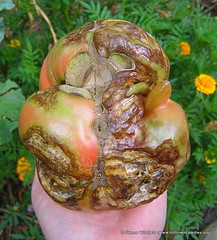Home Garden Challenges Offer Teachable Moments
Blueberries & Tomatoes: Under Siege!

This year’s tomato and potato blight are the same blight that wiped out western Massachusetts crops in 2009. And the potato blight is the same blight that cause the Irish potato famine of the 1840’s! Use it as a teachable moment and discover the history of the Irish potato famine. (Photo credit: Sienna Wildfield)
In western Massachusetts, when we think of summer we often think of locally grown foods. Even the most novice gardeners have grown, or are currently trying to grow tomatoes. If they have tried to plant fruits they probably have attempted to grow blueberries and raspberries. Part of the reason that most gardeners have tired these plants is because they are generally easy to grow and give good yields. But in the last decade or so the number of diseases and insects that have started to plague farmers’ fields and home gardens is on the rise. Part of the reason is erratic weather extremes while another reason is increased trade with countries with similar ecosystems whose insects or diseases can easily adapt to our climate while leaving behind the environmental controls of its home country. The good news is there are organic methods to control these culprits as well as teachable moments for kids…
Blueberries & Raspberries
These two fruits, along with many others (apple, peach, cherry, etc..), are under attack from an imported pest called the Spotted Wing Drosophila. This fruit fly is unique in its ability to infest ripe fruit rather then over ripe fruit like other fruit flies. So what does this mean to you? Those berries you have been patiently waiting for might rot on the bush before your very eyes just before you pick them.
The good news is the insect can be easily controlled with different organic methods, like the easy to find organic pesticides, spinosad and pyrethrum. The bad news is the insect can go from egg to adult in as little as 10 days & has up to 10 generations per year. Translation: if you want to control this pest you may need to spray 5+ times in mid-late summer.
But all is not lost. Families can used this horticultural home garden calamity as a “teachable moment” with their kids. Learn about the life cycle, host species and environmental controls of the Spotted Wing Drosophila and even participate as citizen scientists with the Eastern Spotted Wing Drosophila Volunteer Monitoring Network.
There are many things you can do from a holistic point of view to flight the fly. Just like the human body, the plant is more likely to be able to withstand a pest if the plant is as healthy as possible.
Tomato & Potato Late Blight
This is the same blight that wiped out local crops of tomatoes and potatoes in western Massachusetts in 2009. While there are many “blights” that affect tomatoes, nothing compares to Phytophthora infestans (Latin for “plant destroyer”) for its speed and efficiency. Just like in 2009, the environmental conditions are perfect this summer for its return: very wet early summer. It was found in Franklin County two weeks ago!
The good new is it can be controlled with an organic spray of copper. The bad news is coppers efficacy is only moderate and and the number of times your tomatoes and potatoes need spraying (depending on the weather) can be again up to five times.
But just like the Spotted Wing Drosophila, this blight offers teachable moment too. This is the same blight that cause the Irish potato famine of the 1840’s. Its presence change the face of Europe and America. It presence is the quintessential example of the “Colombian Exchange” as described by local author Charles Mann in his latest book, 1493: Uncovering the New World Columbus Created. A GREAT read for teens and adults. A title to consider for children 8 and older would be Life on a Famine Ship: A Journal of the Irish Famine 1845-1850
, a book that uses pop-up illustrations to tell the story of the Irish potato famine of the 1840s.
Growing your own food is not easy. But revolution starts with the fork.
ABOUT THE AUTHOR
Jim McSweeney
 Jim is a certified arborist, certified horticulturist, licensed pesticide applicator (needed for the application of organic pesticides in MA) & a professional landscape designer with over 15 years experience. He is also the owner of Hilltown Tree & Garden LLC. Jim is on the faculty at the New England Wildflower Society, teaching courses on a diverse range of topics. He lives and works in Zone 5 (Chesterfield, MA) with his family. Once a month here on Hilltown Families you will find timely gardening tips, from a pro in the field, that can be easily used by both avid and novice gardeners, specific to Western MA.
Jim is a certified arborist, certified horticulturist, licensed pesticide applicator (needed for the application of organic pesticides in MA) & a professional landscape designer with over 15 years experience. He is also the owner of Hilltown Tree & Garden LLC. Jim is on the faculty at the New England Wildflower Society, teaching courses on a diverse range of topics. He lives and works in Zone 5 (Chesterfield, MA) with his family. Once a month here on Hilltown Families you will find timely gardening tips, from a pro in the field, that can be easily used by both avid and novice gardeners, specific to Western MA.
 Hilltown Families
Hilltown Families 





























